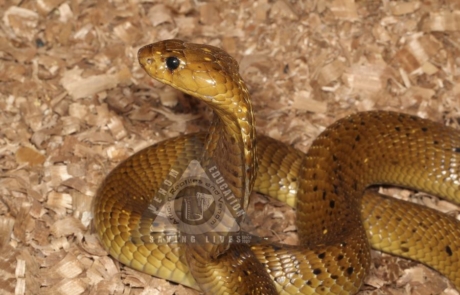Cape Cobra
VERY DANGEROUS
This is a long and slender snake, becoming robust when large. Adults measure from 1,2 m – 1,8 m. The head is slightly distinct from the neck but broad with well-developed muscles in the temporal region that bulge over venom glands in large adults. The pupil is round with a dark iris. The colour in a Cape Cobra is highly variable and can be plain, dark-mahogany, chocolate-brown, bronze, copper, dark-yellow to bright copper colour, light butter-yellow, and often speckled or with dark blotches on the body. Juveniles have a broad, dark throat band (starting immediately under the head) that fades with age. They have smooth and shiny dorsal scales in 19 – 21 rows at mid-body. The subcaudal scales are paired and the anal shield is entire.
Fixed front fangs. The snake does not spit.

The Cape Cobra is one of the most venomous cobras in Africa. They have a potent neurotoxin causing paralysis of the lungs and eventuallydeath. The lethal dose for an adult is 15 – 20 mg and the snake’s venom yield is 60 – 160 mg, with an average of 100 mg. The are numerous annual reports of bites and deaths, especially in children. Early injection of adequate quantities of polyvalent anti-venom is essential. A BITE FROM THIS COBRA IS A REAL MEDICAL EMERGENCY. Polyvalent anti-venom is available.
They are very common in arid areas of the country, preferring dry, scrub country. They inhabit holes created by other animals as a permanent retreat.
Th Cape Cobra is diurnal but during extremely hot and dry conditions they are only active toward the evenings. They prey on mice, rats, lizards, toads and frogs. They are also cannibalistic, preying on other snakes like Puff adders, but also on members of its own species. They enter human habitation while foraging for prey.
They are curious and bold and usually try to escape. If cornered, they will face the aggressor, raising the front portion of the body off the ground, spreading a broad hood. From this position the snake will lunge forward attempting to bite anybody within close proximity. It will retreat when left alone, keeping a wary eye on intruder, ready to turn and repeat the defensive stance when approached too closely.
They reproduce by laying eggs.









